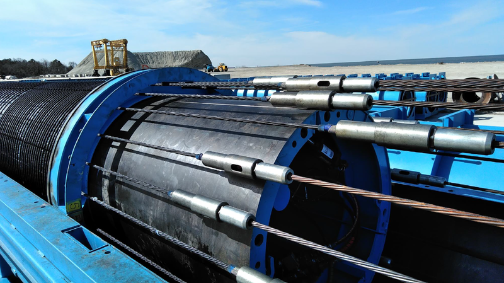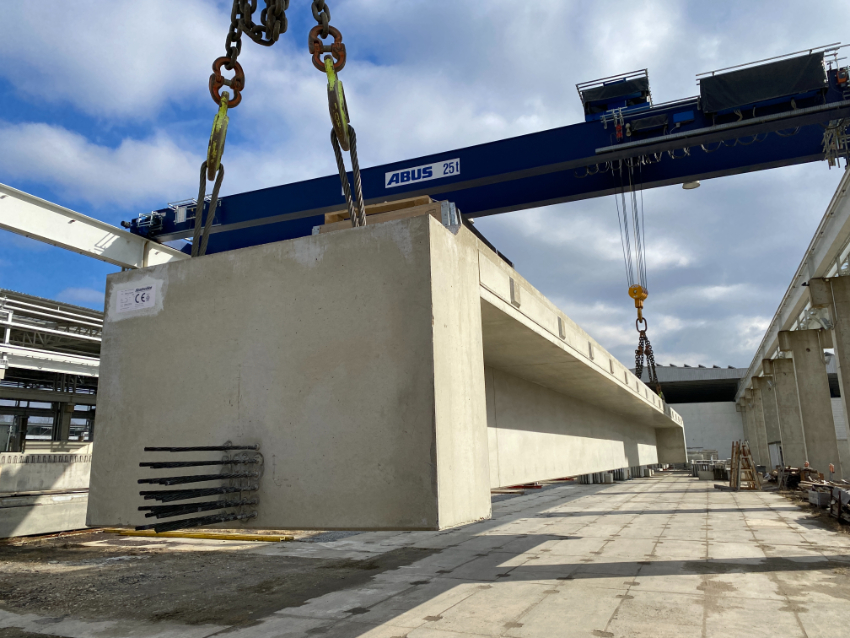
Carbon Fiber Composite Cable (CFCC)
Tout projet d'infrastructure commence par un engagement envers la qualité. Pourtant, la corrosion, la maintenance élevée et la fatigue des matériaux sont des obstacles coûteux. Et s'il existait un moyen d'éliminer ces problèmes dès le départ ?
Le CFCC® de Tokyo Rope est conçu pour être la solution pour les professionnels qui exigent plus : une résistance à la traction élevée, aucune rouille et une perte de relaxation minimale. Le CFCC® réduit le besoin de réparations, ce qui permet d'économiser du temps, de l'argent et des ressources.
Mieux encore, la mise en œuvre du CFCC® n'entraîne AUCUN COÛT SUPPLÉMENTAIRE.
La technologie avancée utilisée pour les câbles en fer traditionnels est entièrement compatible avec les câbles composites en fibre de carbone, ce qui signifie qu'aucun nouvel équipement ou infrastructure n'est nécessaire. Vous pouvez passer en toute transparence aux performances supérieures du CFCC® sans frais de mise en œuvre supplémentaires, maximisant ainsi votre retour sur investissement dès le premier jour.
Product Features
- Résistance élevée à la traction : le CFCC® offre une résistance à la traction deux fois supérieure à celle de l’acier standard, offrant ainsi une plus grande stabilité structurelle.
- Composition sans corrosion : Fabriqué à partir de fibre de carbone et de résine époxy, le CFCC® surpasse même l'acier revêtu en termes de résistance à la corrosion.
- Faible perte de relaxation : assure une fiabilité structurelle à long terme en maintenant la tension au fil du temps.
- Durabilité environnementale : Le CFCC® résiste aux conditions extrêmes (environnements acides, alcalins et à haute température) sans se détériorer.
- Coûts du cycle de vie réduits : au fil du temps, le CFCC® réduit considérablement les coûts de maintenance et de remplacement, permettant des économies à long terme pour les projets difficiles.
Spécifications techniques détaillées – La science derrière les performances du CFCC®

Çekme Gücü et Dayanıklılık
CFCC®'nin Yüksek Performansı: "Celikle karşılaştırılabilir çekme gücü sunan ancak çevresel aşınmaya karşı üstün direction gösteren CFCC®, projelerinizi güçlü, güvenilir et güvenli tutar."
Teknik Grafikler: Yük-gerinim eğrileri, çekme yorulma verileri ve karşılaştırmalı gerilim-gerinim grafikleri.
Gevşeme e Sürünme Verileri
Yük Altında Güvenilir: "Geleneksel çeliğin yarı gevşeme kaybı ve ihmal edilebilir sürünme ile CFCC® uzun vadeli stres altında tutarlı bir performans gösterir."
Veri Aperçu : CFCC® et ces performances pour vos performances Le graphique est utilisé pour que la bile sénaryolaire CFCC soit utilisée pour le traitement et le contrôle vurgulaire.
Cevresel Direnç
Korozyona e Kimyasallara Karşı Dayanıklık : "Asidik veya alcalin ortamlara maruz kalsın, CFCC® bozulmadan güçlü kalır ve çeliğin basarısız olabileceği yerlerde uzun ömür sağlar."
Kanıta Dayalı Karşılaştırma: Hem asidik hem de yüksek sıcaklıktaki alcalin koşullarda maruz kalma testinden elde edilen sonuçlar.
Financière et Çevresel Etki – Daha İyi İnşa Etmek, Daha Fazla Tasarruf Etmek

Yaşam Döngüsü Maliyet Analizi
Tasarrufları Vurgulayın : « Corozyon direnci ve düşük bakımı ile CFCC®, çelikle Vous avez un problème avec %30'a kadar tasarruf sağlar. Daha az bakım, daha az masraf anlamına gelir ve kaynakları en önemli yerlere tahsis etmenizi sağlar. karşılaştıran e tasarruf potansiyelini gösteren basit görselleştirme.
Cevre Dostu Avantajlar
Dayanıklı e Sürdürülebilir: CFCC®, değiştirme ihtiyacını azaltarak ve kaynak tüketimini düşürerek çevre dostu inşaata katkıda bulunur. Il s'agit d'une solution qui vous permettra d'obtenir une réponse complète.
Destekleyici Alıntı : « CFCC® altyapının bir kez inşa edilip uzun süre kullanılabilmesini sağlayarak çevresel etkiyi en aza indirir. »
des renforts pour les générations futures
| Name | Weight (g/m) | Diameter (mm) | Material |
|---|---|---|---|
 CFCC 1x7 D12,5
CFCC 1x7 D12,5 |
146 | 12,5 | Carbon |
Reference project
Product Applications
Preuve de performance – Projets CFCC® en situation réelle
Étude de cas n° 1 – Pont du sentier Beddington
Défi : L'environnement extrêmement corrosif nécessitait un matériau hautement résistant et durable.
Solution : En appliquant du CFCC® sur les poutres du pont, le risque de corrosion a été éliminé et les besoins de maintenance ont été réduits.
Résultats : L'intégrité structurelle a été maintenue pendant des années sans détérioration, démontrant ainsi l'extraordinaire durabilité du CFCC.
Étude de cas n° 2 – Ligne d'essai de Maglev de Yamanashi
Défi : les interférences magnétiques devaient être évitées dans cette ligne de transport innovante.
Solution : le CFCC® a été utilisé pour les poutres de guidage non magnétiques.
Résultats : il a assuré un fonctionnement fluide sans interférence et a renforcé le rôle du CFCC dans les infrastructures d'avenir.
Vous n'êtes pas prêt à vous engager ?
Téléchargez notre guide technique détaillé sur le CFCC® et découvrez pourquoi les projets les plus ambitieux au monde choisissent Tokyo Rope.
Découvrez comment le CFCC peut transformer votre projet
Demandez un devis, parlez à un expert ou téléchargez la spécification
- Amélioration des performances
- Manutention et logistique
- Conformité et compatibilité
- Application et installation
- Durabilité et résistance
- Durabilité et impact environnemental
- Is solidian GRID suitable for replacing corroded steel reinforcement?
- How does solidian GRID contribute to system durability when used with mortars?
- Can solidian GRID conform to curved surfaces during installation?
- How does the weight of solidian GRID affect transportation and installation?
- Is there an Environmental Product Declaration available for solidian GRID and solidian REBAR?
- Has solidian GRID received official building approvals?
- With which types of binders is solidian GRID compatible?
- Is solidian GRID approved for use in standard concrete applications?
- What is the minimum thickness required for concrete layers using solidian GRID?
- Can solidian GRID be used to reinforce existing concrete structures?
- What is the expected lifespan of solidian GRID in wastewater applications?
- How does solidian GRID perform in acidic environments?
- How does solidian GRID contribute to sustainable construction?
- Resource efficiency: By minimizing the need for extra concrete cover, solidian GRID conserves materials such as cement and aggregates, contributing to resource efficiency.
- Environmental Product Declarations (EPDs): solidian provides transparent data on the environmental impact of their products through EPDs, facilitating informed decision-making for sustainable building projects.
Solidian Kelteks - Reduced CO₂ emissions: The use of solidian GRID in construction can lead to significant reductions in CO₂ emissions due to decreased material usage and enhanced durability, which extends the lifespan of structures and reduces the need for repairs.
questions fréquemment posées
Yes, in cases where steel reinforcement has corroded, solidian GRID can serve as a substitute for structural reinforcement. The existing corroded steel can remain in place and be covered with a new layer of carbon-reinforced mortar, restoring structural integrity.
When combined with high-quality mortars, solidian GRID significantly enhances the overall durability of the system, providing a robust solution for demanding environments.
Yes, solidian GRID strikes a balance between stiffness and flexibility, allowing it to be applied to curved surfaces with diameters greater than 800mm.
The lightweight nature of solidian GRID facilitates easy transportation, even through sewage tunnels, and simplifies the installation process, reducing labor and equipment requirements.
Yes, a certified Environmental Product Declaration (EPD) is available for both solidian GRID and solidian REBAR. The EPD provides transparent and verified information about the environmental impact of these products throughout their life cycle, supporting sustainability assessments in construction projects.
Yes, solidian GRID has obtained the General Building Approval (abZ) from the German Institute for Building Technology (DIBt). This approval authorizes its use as carbon reinforcement grids in construction, ensuring compliance with national building standards.
solidian GRID is versatile and works with a range of binders, including Portland Cement, Calcium Aluminate Cements, and Geopolymer Cements.
solidian GRID holds German Approval as reinforcement for EN 206 concretes, supporting its compatibility with various mortar systems, including those adhering to DIN 19573.
Concrete layers reinforced with solidian GRID can be as thin as 20mm, as no additional concrete cover is needed to protect the reinforcement from corrosion.
Yes, solidian GRID can be applied as an additional layer over existing steel-reinforced concrete. When combined with solidian ANTICRACK, it offers enhanced crack-limiting properties, providing extra protection to the underlying steel reinforcement.
Classified under XWW4, solidian GRID ensures long-term performance for over 50 years, making it a durable choice for long-term infrastructure projects.
solidian GRID is fully resistant to severe acidic conditions, including environments with pH levels as low as 0. It has successfully passed tests in accordance with DIN 19573 standards for pH 0 and pH 1.
solidian GRID enables the design of thinner concrete layers (greater than 20mm) without requiring additional concrete cover for reinforcement protection. This reduction in material usage leads to lower resource consumption and a diminished environmental footprint, supporting more sustainable construction practices.
Additional information:




